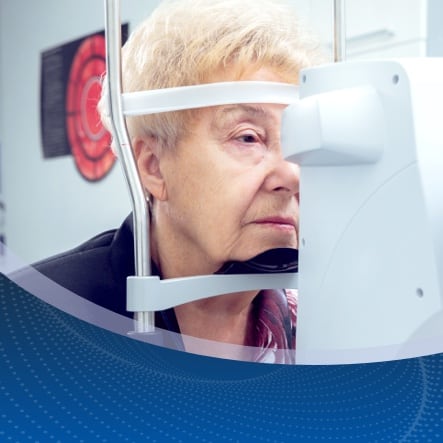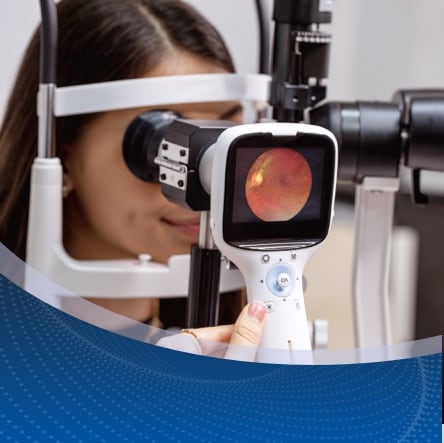

What is Glaucoma?
Glaucoma is a disease of the optic nerve – the part of the eye that carries the images we see to the brain. The optic nerve is made up of many nerve fibers, like an electric cable containing numerous wires. When damage to the optic nerve fibers occurs, blind spots develop. These blind spots usually go undetected until the optic nerve is significantly damaged. If the entire nerve is destroyed, blindness results.
Early detection and treatment by your ophthalmologist are keys to preventing optic nerve damage and blindness from Glaucoma. Loss of sight from Glaucoma can often be prevented with early treatment.
Glaucoma is the second-leading cause of blindness worldwide, affecting over 3 million Americans. Although there is no cure for glaucoma, it is preventable, and there are treatment options to help save your sight.
Book a comprehensive eye exam with Griffey Eye Care & Laser Center to manage your eye health.
What Causes Glaucoma?
In patients receiving glaucoma care in Chesapeake, a clear liquid called aqueous humor circulates inside the eye, helping maintain pressure and overall eye health. To maintain a healthy level of pressure within the eye, a small amount of this fluid is produced constantly while an equal amount flows out of the eye through a microscopic drainage system. (This liquid is not part of the tears on the outer surface of the eye.)
Because the eye is a closed structure, if the drainage area for the aqueous humor–called the drainage angle–is blocked, the excess fluid cannot flow out of the eye. Fluid pressure within the eye increases, pushing against the optic nerve and causing damage.
What are the Different Types of Glaucoma?
Chronic open-angle Glaucoma is the most common form of Glaucoma in the United States. The risk of developing chronic open-angle Glaucoma increases with age. The drainage angle of the eye becomes less efficient over time, and pressure within the eye gradually increases, which can damage the optic nerve. In some patients, the optic nerve becomes sensitive even to normal eye pressure and is at risk for damage. Treatment is necessary to prevent further vision loss.
Typically, open-angle Glaucoma has no symptoms in its early stages and vision remains normal. As the optic nerve becomes more damaged, blank spots begin to appear in your field of vision. You typically won’t notice these blank spots in your day-to-day activities until the optic nerve is significantly damaged and these spots become large. If all the optic nerve fibers die, blindness results.
Closed-angle Glaucoma occurs when eyes are formed with the iris (the colored part of the eye) too close to the drainage angle. In these eyes, which are often small and farsighted, the iris can be sucked into the drainage angle and block it completely. Since the fluid cannot exit the eye, pressure inside the eye builds rapidly and causes an acute closed-angle attack.
For Close-angle glaucoma, symptoms may include:
- Blurred vision
- Severe eye pain
- Headache
- Rainbow-colored halos around lights
- Nausea and vomiting
This is a true eye emergency. If you have any of these symptoms, call our office immediately. Unless this type of Glaucoma is treated quickly, blindness can result.
Unfortunately, two-thirds of those with closed-angle Glaucoma develop it slowly without any symptoms prior to an attack.
Who is at Risk for Glaucoma?
The most important risk factors include:
- Age
- Elevated eye pressure
- Family history of Glaucoma
- African or Spanish ancestry
- Farsightedness or nearsightedness
- Past eye injuries
- Thinner central corneal thickness
- Systemic health problems, including diabetes, migraine headaches and poor circulation
Your ophthalmologist will weigh all of these factors before deciding whether you need treatment for Glaucoma or whether you should be monitored closely as a Glaucoma suspect. This means your risk of developing Glaucoma is higher than normal, and you need to have regular examinations to detect the early signs of damage to the optic nerve.

How is Glaucoma Detected?
Regular eye examinations by your ophthalmologist are the best way to detect Glaucoma. A Glaucoma screening that checks only the pressure of the eye is not sufficient to determine if you have Glaucoma. The only sure way to detect glaucoma is to have a complete eye examination.
During your Glaucoma evaluation, your ophthalmologist will:
- Measure your intraocular pressure (tonometry)
- Inspect the drainage angle of your eye (gonioscopy)
- Evaluate whether or not there is any optic nerve damage (ophthalmoscopy)
- Test the peripheral vision of each eye (visual field testing)
Photography of the optic nerve or other computerized imaging may be recommended. Some of these tests may not be necessary for everyone. These tests may need to be repeated on a regular basis to monitor any changes in your condition.
How is Glaucoma Treated?
As a rule, damage caused by Glaucoma cannot be reversed. Our trusted glaucoma specialists in Chesapeake offer comprehensive treatment options, including medications, laser therapy, and surgical interventions to prevent further vision loss. In some cases, oral medications may also be prescribed.
Medications
Glaucoma is usually controlled with eye drops taken daily. These medications lower eye pressure, either by decreasing the amount of aqueous fluid produced within the eye or by improving the flow through the drainage angle.
Laser Surgery
Laser treatments may be recommended for different types of Glaucoma. In open-angle Glaucoma, the drain itself is treated. The laser is used to modify the drain (trabeculoplasty) to help control the eye pressure. In closed-angle glaucoma, the laser creates a hole in the iris (iridotomy) to improve the flow of the aqueous fluid to the drain.
Surgery
When surgery is needed to treat Glaucoma, your ophthalmologist uses fine microsurgical instruments to create a new drainage channel for the aqueous fluid to leave the eye. Surgery is recommended if your ophthalmologist feels it is necessary to prevent further damage to the optic nerve. As with laser surgery, surgery in the operating room is typically an outpatient procedure.
What is My Role in Treatment?
With any type of Glaucoma, periodic examinations are very important to prevent vision loss. Because Glaucoma can progress without your knowledge, adjustments to your treatment may be necessary from time to time. Glaucoma treatment requires teamwork between you and your doctor. Your ophthalmologist can prescribe treatment, but only you can make sure that you follow your doctor’s instructions and use your eyedrops.
Schedule a consultation with our glaucoma specialist in Chesapeake, VA, to explore your personalized treatment options and protect your vision.
Our Locations
Our Testimonials
I recently went to my family doctor for pain I’d been having in my eye that was moving down my neck. I’d been waiting to have an MRI scheduled, and it was taking forever. I wanted to get a second opinion about what course of action should be taken. My husband and daughter are both patients at this practice and have always received stellar treatment. Dr. Griffey took very good care of me and went the extra step to send a letter to my family doctor while I was still there to concur with what they had said and also confirm that he would suggest an MRI as well. I was very impressed with him and his patient care. And, I appreciate the staff (particularly Tara and Benita) in scheduling me in as soon as possible. I would highly recommend this practice! Thank you all again for your help.
Beth K
I was referred to Dr. Griffey by several people. I was told he was an excellent ophthalmologist, and they were right. This was my first time meeting him and he made me feel so safe, comfortable and confident that he was providing me with the best and most knowledgeable treatment I could ask for. As I sat in the chair, I observed him interact with a baby he kissed on the forehead, it was so special to see him do that because it showed a gentle side of him, and his interaction with his assistants was nice, professional and straight to the point of what he needed in order to help his patient, I remember him saying to one of them that he was not going to let me leave until he reviewed a report from another doctor about my condition and that really made me feel special because it showed his concern. I don’t think I could have asked for a better doctor. Thank you Dr. Griffey for being the best and hats off to your father and grandfather.
C. Blount
I had a wonderful first appointment. The staff is attentive and the techs and doctors are knowledgeable and take their time really getting to know their patients. So happy to have found them.
M. Catherine
I travel from Atlanta, Georgia to see Dr. Griffey, MD, and board certified Ophthalmologist. Dr. Griffey has performed two surgeries on me and I would trust him to do anything he deems necessary. The staff is fantastic and I would recommend Dr. Griffey, to all that needed to see a competent Ophthalmologist!!!
M.Bailey Buck
I want to thank everyone at Chesapeake Eye Care for their care on a recent visit. I had an accident involving my eye and even though they were booked, the receptionist worked me in that day. The technician and Dr. Fox saw me promptly and performed a thorough exam. I was very pleased with both of them and appreciated their kindness and professionalism.
P. Brangan
My dad had cataract surgery a couple years ago. I was a little nervous for him, he’d been resisting getting surgery for so long. However, the staff and Dr. Griffey were wonderful to him and everything went very smoothly. He had a great experience, and I am thankful to them for making him so comfortable.
K. Kroll
The best thing I ever did was get LASIK surgery; it is unbelievable how I can see 20/20. When I get in bed at night I still think … wait….no, I don’t have to take my contacts out and it’s been 3 months. It was wonderful in Mexico also with not having to worry about contacts and all the solutions to bring with me. I had an amazing experience with my LASIK surgery with Dr. Paul Griffey and his staff! I would definitely recommend him to friends and family!!!
E. McConnell
I sent my mom to Dr. Griffey for a 2nd opinion on her eyes. Years later, I am still satisfied with the care he has provided. She had an appointment today and Dr. Griffey called me personally to discuss my concerns. WOW!!!!! GREAT PROVIDER!!!!!! I also referred my dad to him after a bad cataract surgery elsewhere. Dr Griffey did his 2nd eye without complications. THANK YOU for taking care of my parents! I have 30+ years in the business as a licensed optician and have worked with many doctors, I would recommend Dr. Griffey to any patient for care!!!!!!!!!!
Selena Cabral
I have been a patient of Dr. Griffey, since 2012. I’m born, raised, formal education, retired Law Enforcement, City of Virginia Beach, VA. After moving to Atlanta, I felt I could not find the care I needed, so I travel back and forth to receive my care. I will not allow anyone to see me. Well worth the trip, and will continue to do so!
Thank you for being The Best…
MBB
We both underwent cataract surgery, in both eyes. Barbara’s was in September of 2018. Mine was in December 2018. We both had excellent experiences, from her first visit, to my last. Dr. Griffey, as well as everyone on his staff, (that we came in contact with), were prompt and very professional. Yet, at the same time they were relaxed and very friendly. We were very impressed that everyone, asked, if we had any questions.
And, we can both see 20/20 again!!.
There was an general atmosphere of confidence and calmness throughout his practice, as well as within the Chesapeake Surgical Center. That made us both feel very comfortable, and well cared for. We have never before experienced such a well run practice. We have, (and will continue to), highly recommend Dr. Griffey to anyone who needs eye care.
Barbara and Eddie
CHECK US OUT ON SOCIAL


We are a proud partner of US Eye, a leading group of patient-centric, vertically integrated multi-specialty physician practices providing patients with care in ophthalmology, optometry, dermatology and cosmetic facial surgery.









